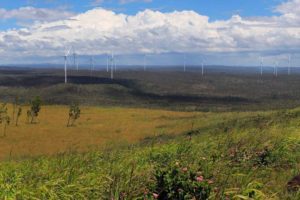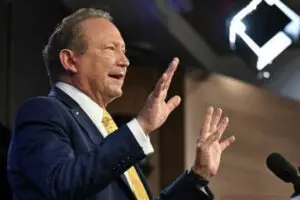Quinbrook Investments, which has teamed up with billionaire Mike Cannon-Brookes to take control of the Sun Cable project in the Northern Territory, the world’s largest solar and battery proposal, is to lead the first stage of construction with a focus on the domestic market.
The development of what could be a $30 billion plus project have effectively been split in two – with Quinbrook taking charge of the domestic component, using its expertise in large scale solar farm developments to secure supplies, customers and co-investors.
Grok Investments, the Cannon-Brookes investment vehicle which also has a stake in Quinbrook, will focus on the potential exporting solar power to Singapore via a sub-sea cable. If that part is successful, then the Sun Cable will potentially be built to the scale originally proposed – 20GW and 42GWh.
Until then, the Sun Cable will be built at a significantly smaller scale, and in stages, with the size limited to the potential of finding new customers and green industries to supply from the solar project in Elliott, and delivered via a proposed 800km transmission line.
“The bare bones of the project looks really attractive to us – and how investors invest with Quinbrook, to give them differentiated opportunities and long-term renewables infrastructure. This ticks a lot of boxes,” Scaysbrook said in a statement on Wednesday.
“Where we feel we can add value is to bring the optimum project solution to the onshore renewables component of Sun Cable, and that makes really a lot of sense because at the end of the day getting the cheapest optimum solution into Darwin is mission critical.”
Scaysbrook also says that Quinbrook is looking to add wind energy to the Sun Cable project. Wind is often a forgotten factor in large solar projects planned for Australian arid regions, but the reality is that it is in fact a strong resource, and often blows mostly during the night time when solar is not operating.
Quinbrook’s strategy is interesting as it appears to be a hybrid version of the two competing visions that Cannon-Brookes and iron ore billionaire Andrew Forrest had for the project.
Cannon-Brookes remains committed to the export potential of a 4,200km sub sea cable, while Forrest said the project would only make sense if it supplied local industry and green hydrogen production.
RenewEconomy understands that Quinbrook was brought in as a moderator between the two billionaires, and ended up in the Grok camp after Forrest withdrew. Two other parties made bids, but these were regarded as token and opportunistic proposals.
Scaysbrook says in his statement that if solar can be provided to Darwin at a competitive price, then it could pave the way to exports to Singapore.
“We’ve got a good handle on the likely build cost for the onshore renewables part, given that’s kind of what we do for a living,” Scaysbrook said.
“I don’t get carried away with all of the tags about this being the biggest renewables project in the world.”
“With a project of this scale, you can deliver enough renewables into Darwin to do domestic green hydrogen manufacture. And you could also export enough of the power up to Singapore that was sort of bandied around as the amount that Singapore would want.”
Scaysbrook said Quinbrook will look to bring in investors from Europe, the UK, the US and Canada as it develops the Sun Cable project.
“This will be a United Nations of global capital represented investing in these projects.”










